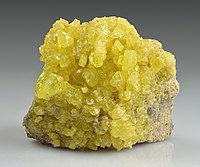
Photo from wikipedia
Hydrogen sulfide (H2S) sensors are in urgent demand in the field of hermetic environment detection and metabolic disease diagnosis. However, most of the reported room-temperature (RT) H2S sensors based on… Click to show full abstract
Hydrogen sulfide (H2S) sensors are in urgent demand in the field of hermetic environment detection and metabolic disease diagnosis. However, most of the reported room-temperature (RT) H2S sensors based on transition metal oxides/salts unavoidably suffer from the poisoning effect, resulting in the unrecoverable behavior to restrain their application. Herein, copper(II) chloride-doped polyaniline emeraldine salt (PANI-CuCl2) was devised for RT-recoverable H2S detection, where the copper ion (Cu2+) was designed as a partial substitution of protons (H+) in PANI. The prepared gas sensor exhibited full recovery capability toward 0.25-10 ppm H2S, good repeatability, and long-term stability under 80% RH. Meanwhile, the changes of the PANI-CuCl2 during the H2S sensing period were analyzed via multiple analytical methods to reveal the reversible sensing behavior. Results showed that doping of Cu2+ not only promoted the PANI's response through the formation of conductive copper sulfide (CuS) and following H+ redoping in the PANI but also facilitated the sensor's recovery behavior because of the Cu2+ regeneration under the H+/oxygen environment. This work not only proves the changes of the interaction between the PANI and Cu2+ during the H2S sensing period but also sheds light on designing recoverable H2S sensors based on transition metal salts.
Journal Title: ACS applied materials & interfaces
Year Published: 2022
Link to full text (if available)
Share on Social Media: Sign Up to like & get
recommendations!